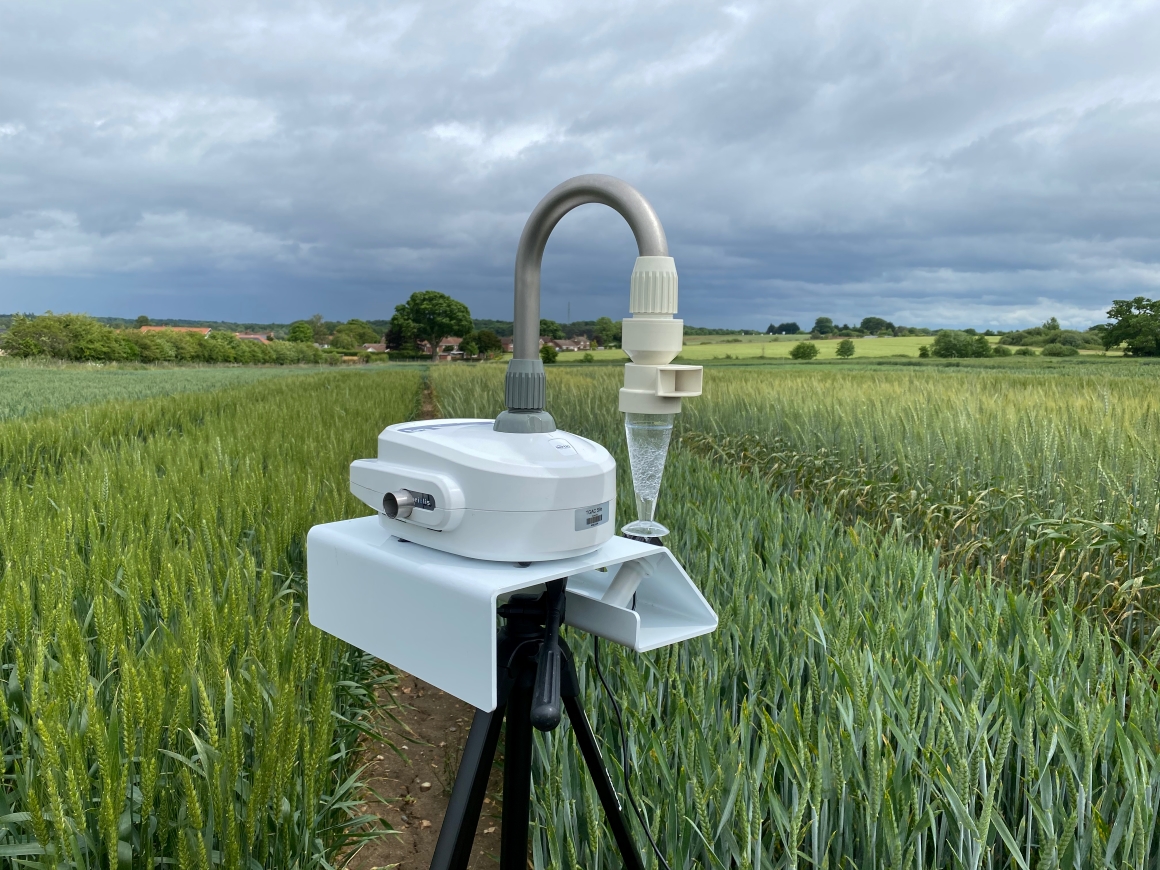Successful trials in England show AirSeq's potential to combat devastating crop diseases

Airseq device operating in a field © Trustees of the Natural History Museum, London
- New AirSeq technology detects airborne crop diseases
- Early pathogen detection can save farmers money and promote sustainable farming practices
- Successful trials in England show AirSeq's potential to combat devastating crop diseases
As farmers across the world work, amidst climate change, to secure global food production, researchers at the Natural History Museum and the Earlham Institute have unveiled AirSeq. This new technology could help to revolutionise agriculture by detecting crop diseases through airborne DNA.
In AirSeq, a device filters thousands of litres of air to capture any biological material – including disease-causing fungi - before, sequencing their DNA, identifying species present, and then measuring their abundance.
The technology represents a huge shift in crop disease management, leveraging advanced DNA sequencing. This innovation not only promises early detection capabilities but also aims to empower farmers with real-time insights to combat diseases efficiently and sustainably.
Prof. Matt Clark, Research Leader at the Natural History Museum said, “At the moment, farmers spray their crops with fungicides to make their plants inhospitable to possible fungal infections, but as different crops are resistant to different pathogen strains, this isn’t always necessary.”
Every year up to 40% of global crops are lost to pests and diseases, costing billions and jeopardising food security. Traditional disease management often reacts too late, after visible symptoms appear. AirSeq, however, flips this paradigm by providing proactive, early detection of pathogens.
Prof. Clark added, “AirSeq can detect which spores are present and how abundant they are, which would allow farmers to see whether or not they need to use fungicides. This means farmers can spray their crops more efficiently, saving them money and promoting more sustainable farming.”
Initial trials in the east of England have successfully proven AirSeq's ability to detect a spectrum of pathogens including those responsible for devastating diseases like powdery mildew and septoria leaf blotch. These findings highlight AirSeq's potential to reshape agricultural practices globally.
Dr Richard Leggett, study author and Group Leader at the Earlham Institute, said, "We believe this is the first time anyone has done whole genome sequencing of the air in an agricultural setting. People have tested for specific pathogens but never sequenced the whole air community - and repeated this over time - to see everything they've captured.
“We've shown that this approach allows you to monitor agriculturally significant pathogens over time. It means we can arm farmers with the data they need to prevent crop losses.”
The team’s aim is to evolve AirSeq into a portable, field-ready device that continuously monitors the air for pathogens, bolstering food security as climate change intensifies disease pressures on crops. Beyond mitigating losses, the technology offers a pathway to sustainable agriculture, minimising chemical inputs and mitigating risks associated with fungicide resistance.
Continued research collaboration between the Natural History Museum and the Earlham Institute aims to advance AirSeq's sensitivity and usability. Together, they remain committed to harnessing the innovation for a more resilient, sustainable agricultural future, and the detection of other airborne diseases which threaten us and our environment.
“We’ve also continued to develop the technology for applications beyond agriculture,” added Dr Leggett. “That includes a recent project to detect human pathogens in urban environments, which combines AirSeq technology with bespoke software for reliable identification of biological threats.”
The new research paper Measuring air metagenomic diversity in an agricultural ecosystem is published in Current Biology.
Notes to editors
Assets
Images are available here
Press Contact
Natural History Museum Press Office
Tel: +44 (0)20 7942 5654 / 07799690151
Email: press@nhm.ac.uk
The Natural History Museum is a world-leading science centre and one of the most visited attractions in the UK. A global source of curiosity, inspiration and joy.
Our vision is to build a future in which both people and the planet thrive.
We aim to be a catalyst for change, engaging advocates for the planet in everything that we do.
Our 350 scientists are finding solutions to the planetary emergency in all aspects of life. Visit, join and support the Natural History Museum today. Protecting the planet. It's in our nature.
The Earlham Institute is a hub of life science research, training, and innovation focused on understanding the natural world through the lens of genomics. Embracing the full breadth of life on Earth, our scientists specialise in developing and testing the latest tools and approaches needed to decode living systems and make predictions about biology.
The Earlham Institute is based within the Norwich Research Park and is one of eight institutes that receive strategic funding from the Biotechnology and Biological Sciences Research Council (BBSRC), part of UKRI, as well as support from other research funders.
Contact
Weekdays: +44 (0)20 7942 5654
Evenings and weekends:
+44 (0)7799 690 151
Email: press@nhm.ac.uk
Don't miss a thing
Receive email updates about our news, science, exhibitions, events, products, services and fundraising activities. We may occasionally include third-party content from our corporate partners and other museums. We will not share your personal details with these third parties. You must be over the age of 13. Privacy notice.
Follow us on social media